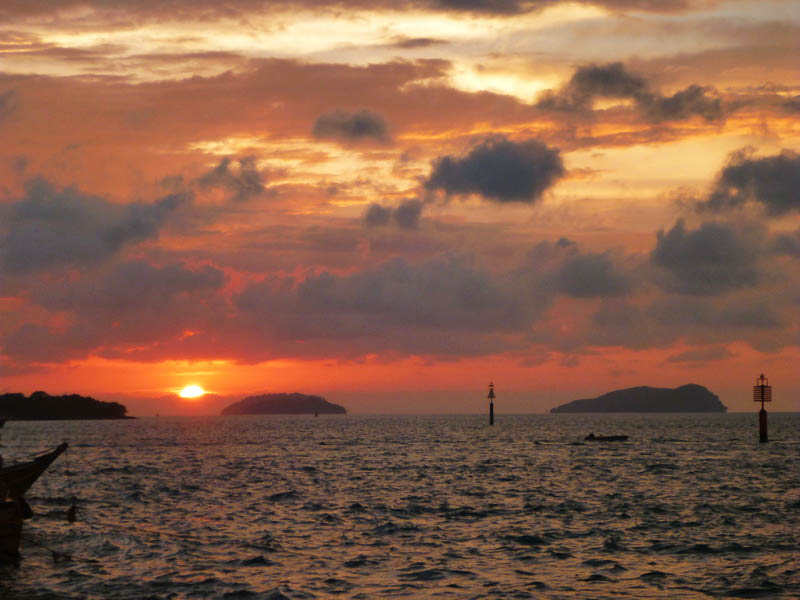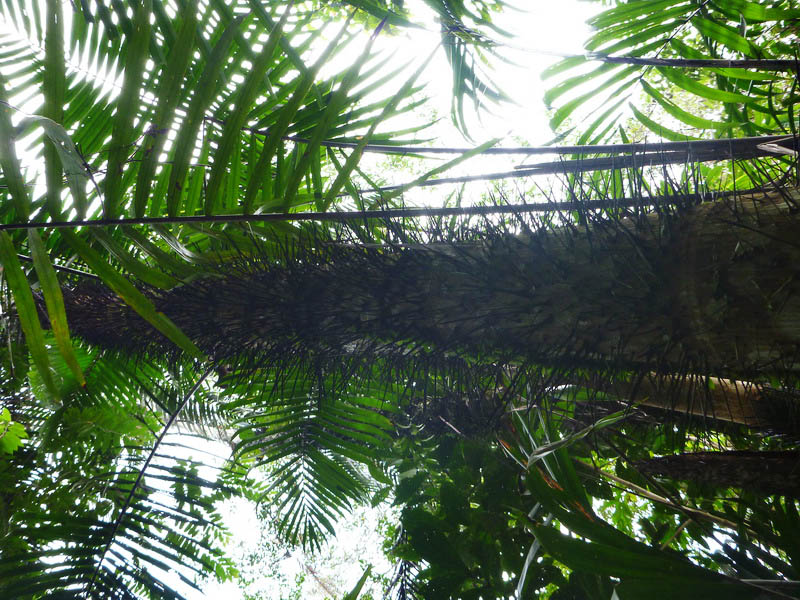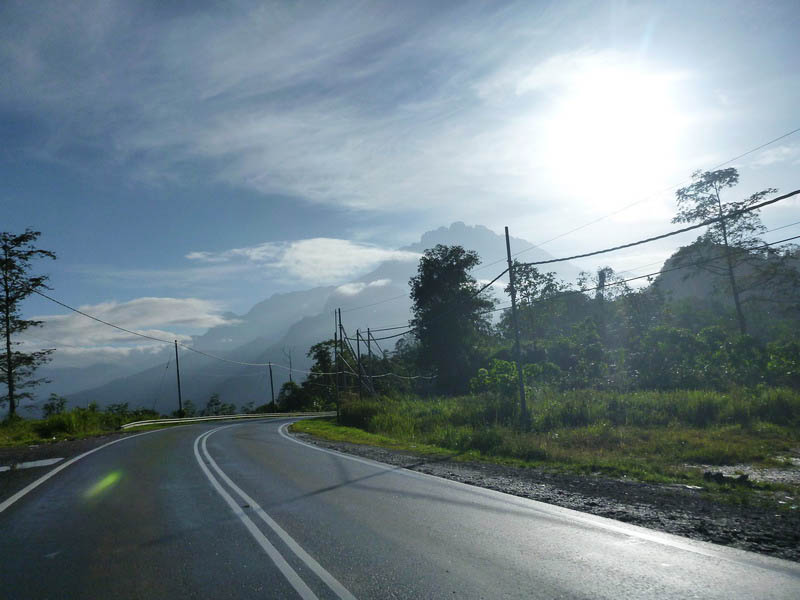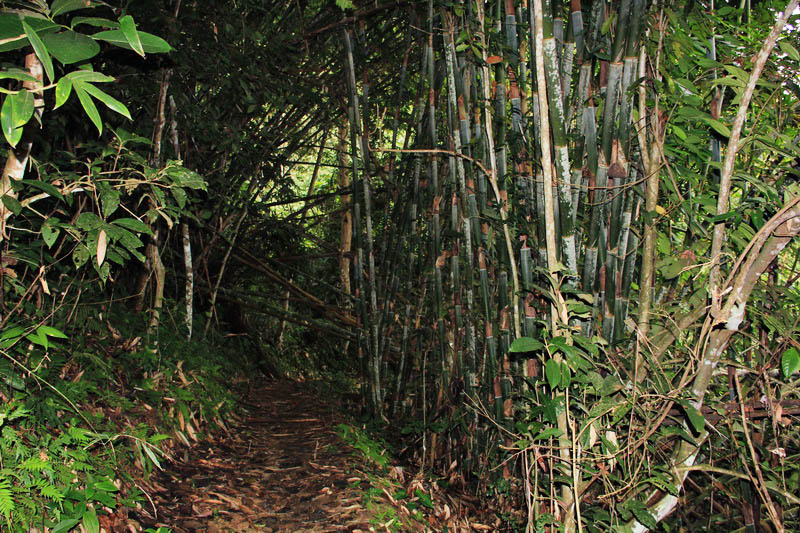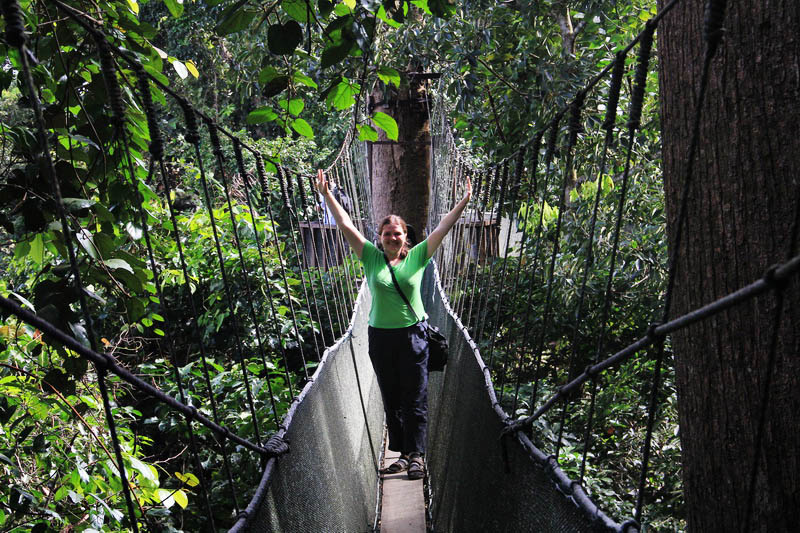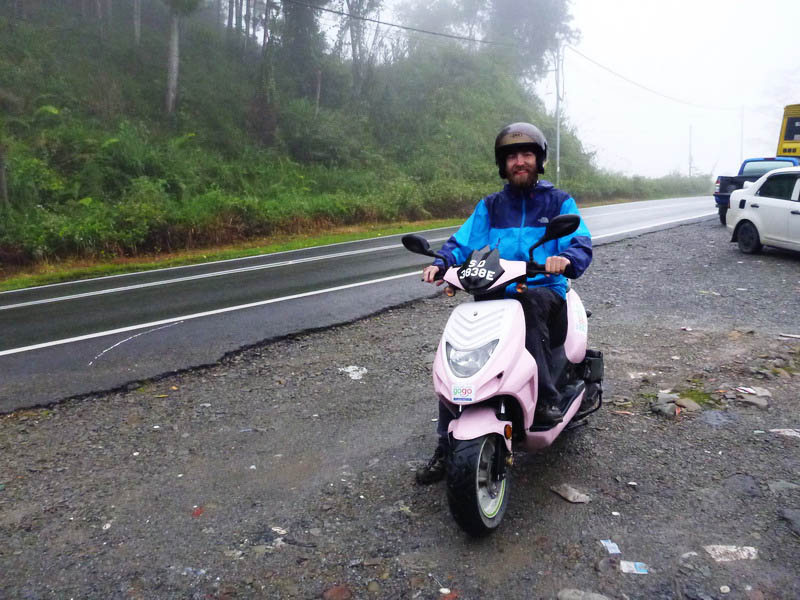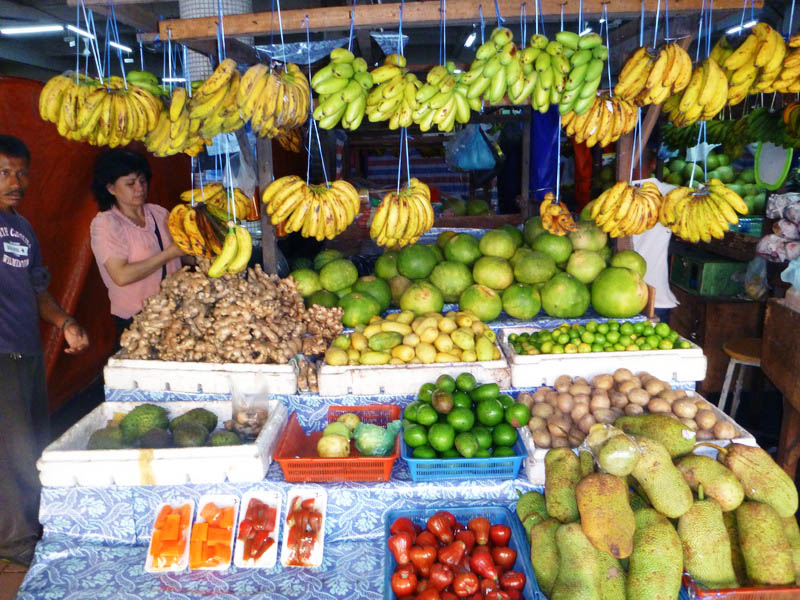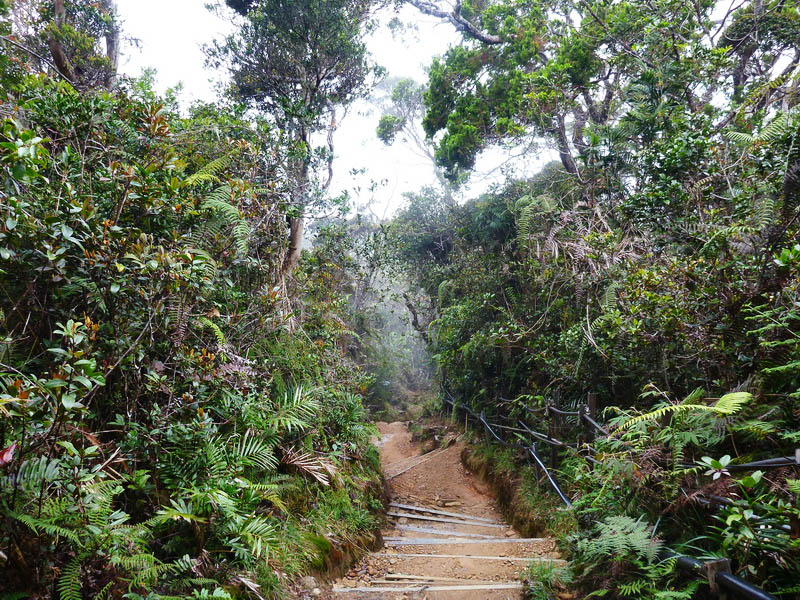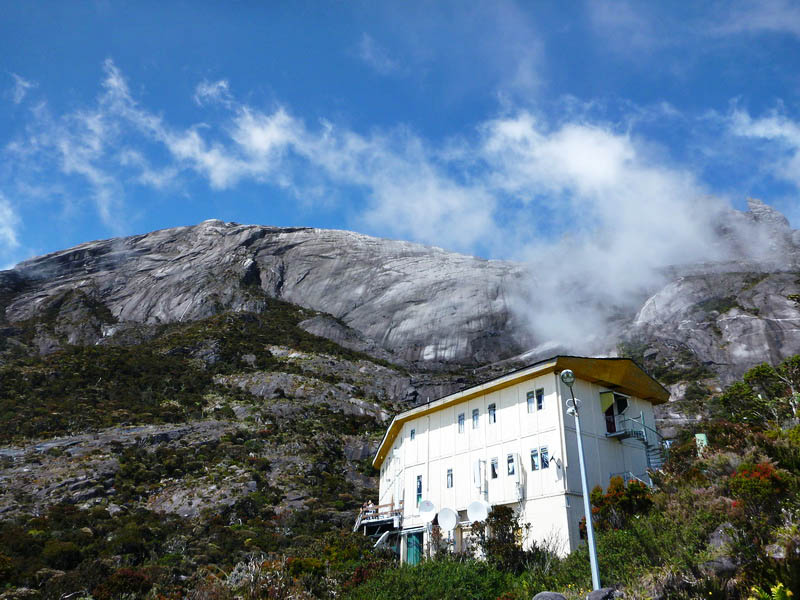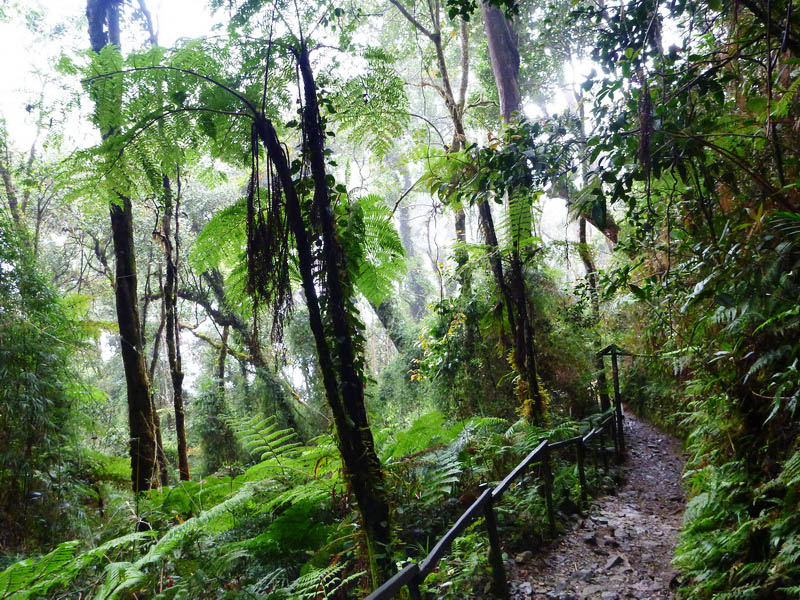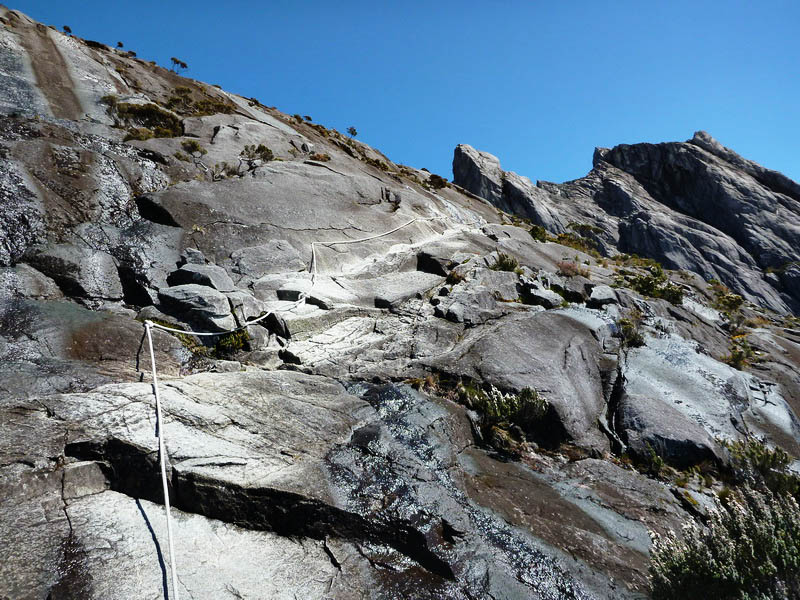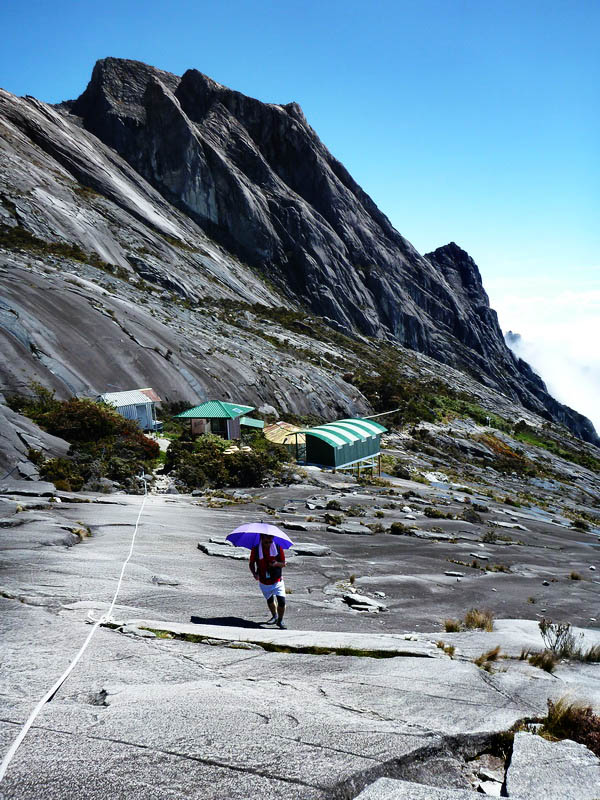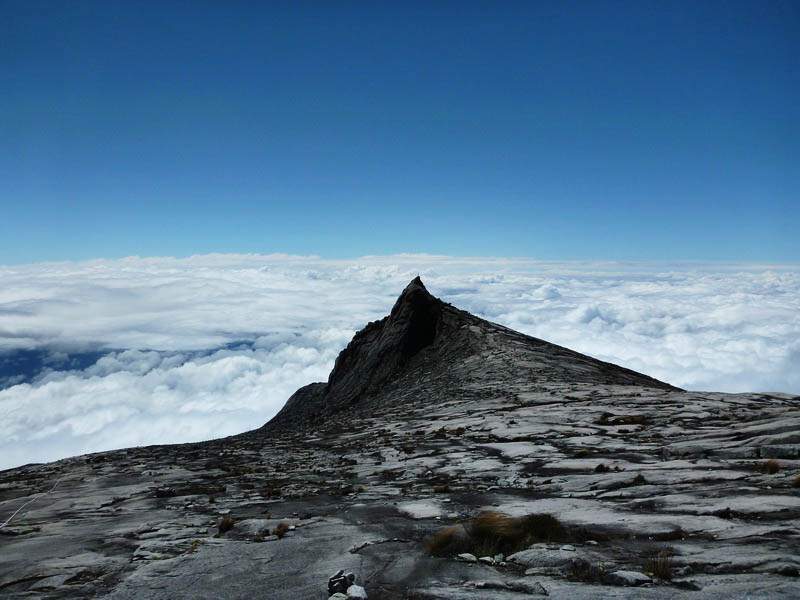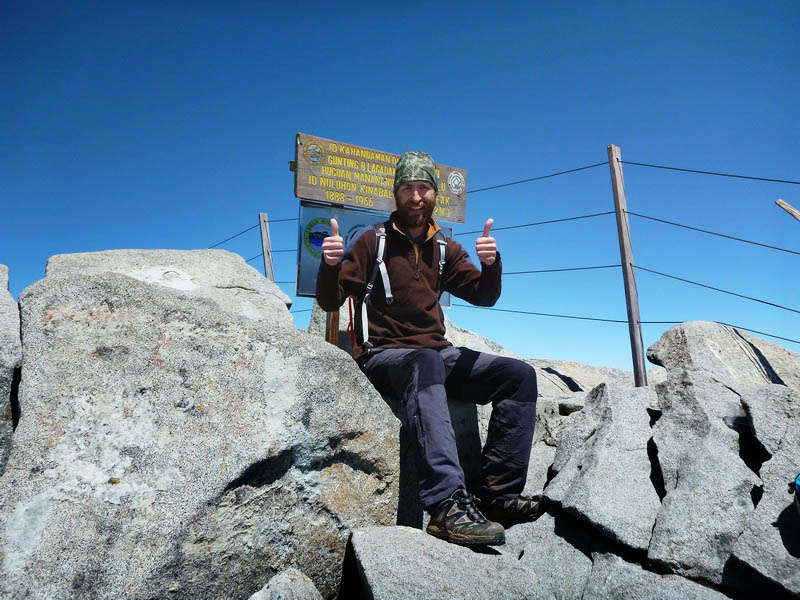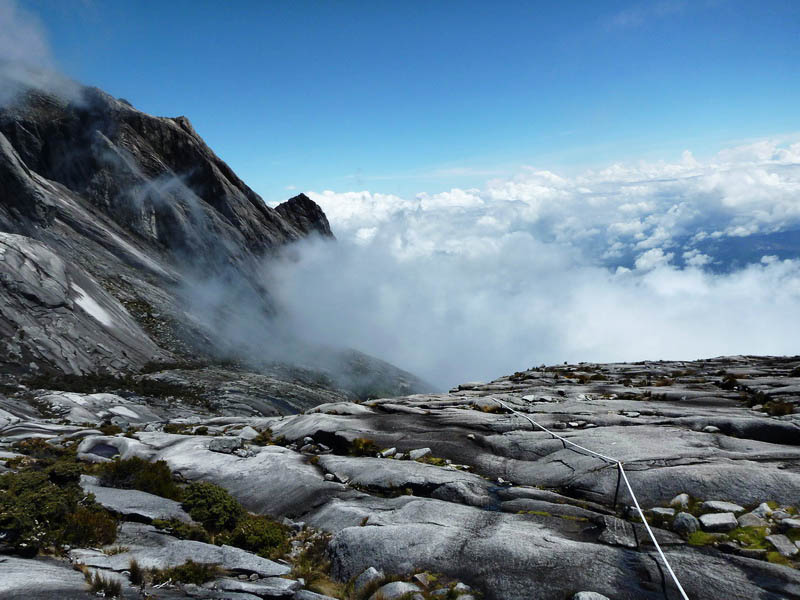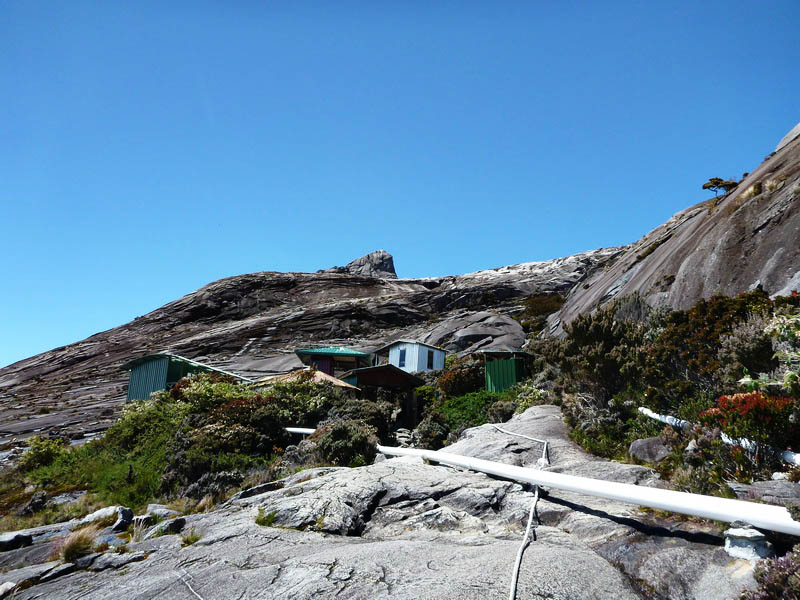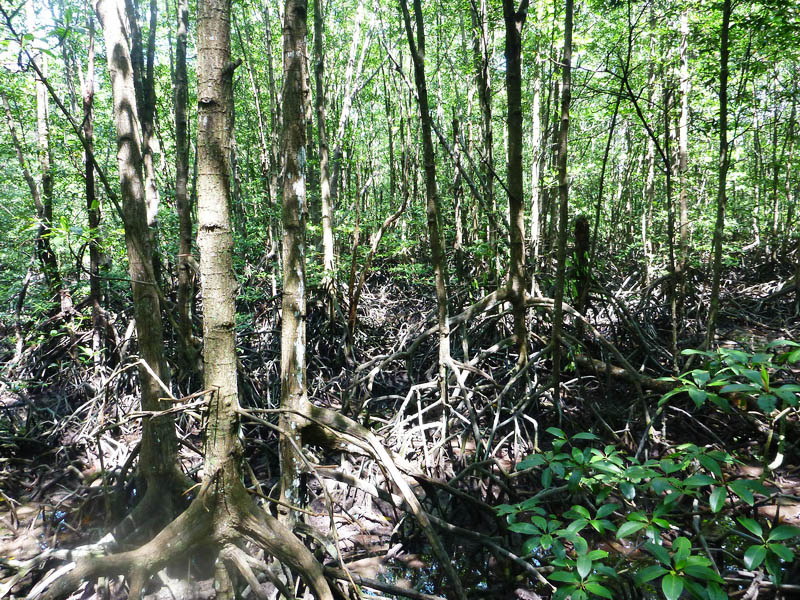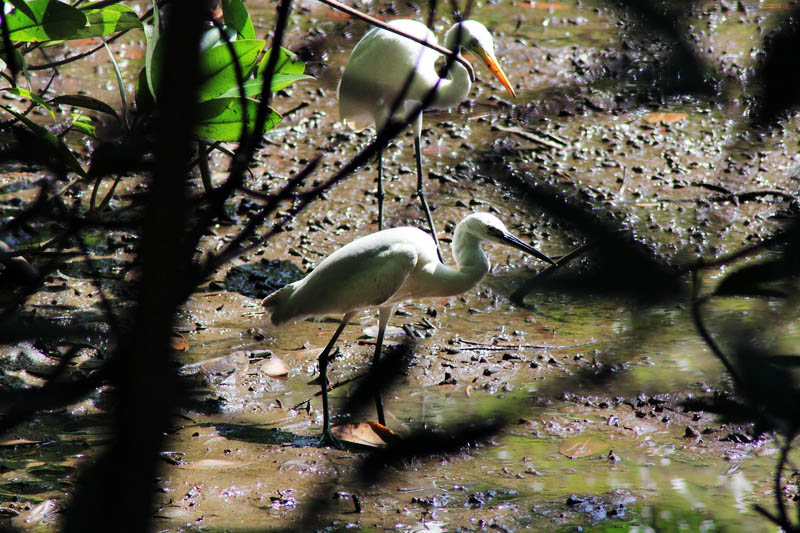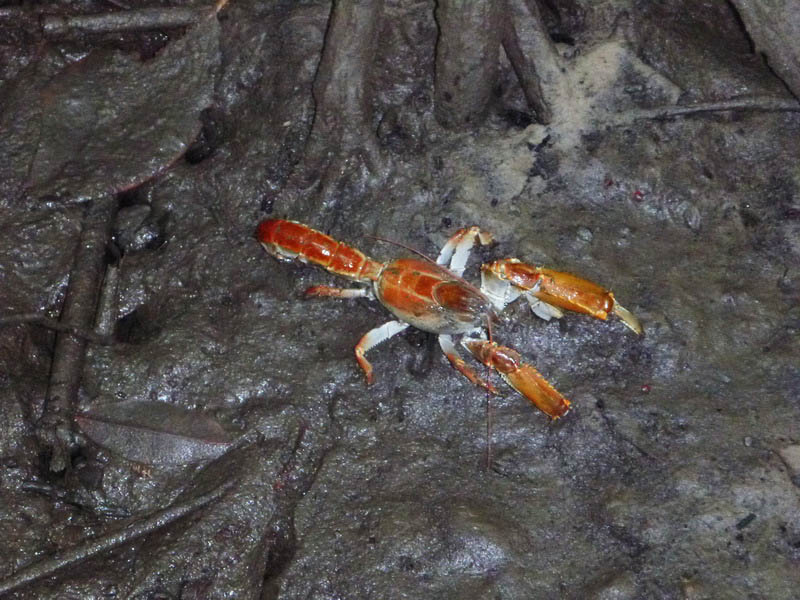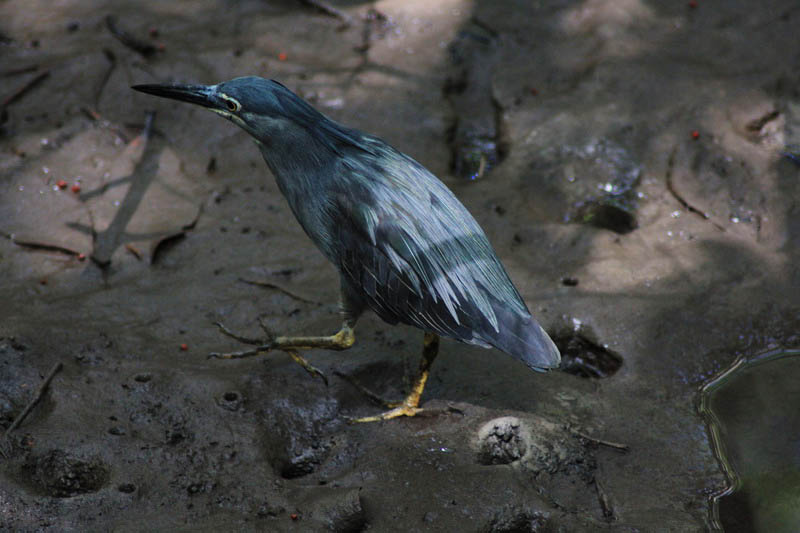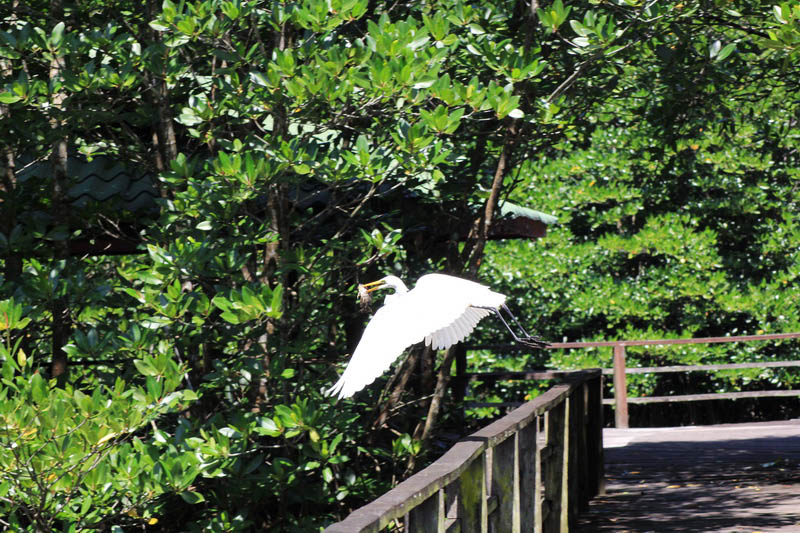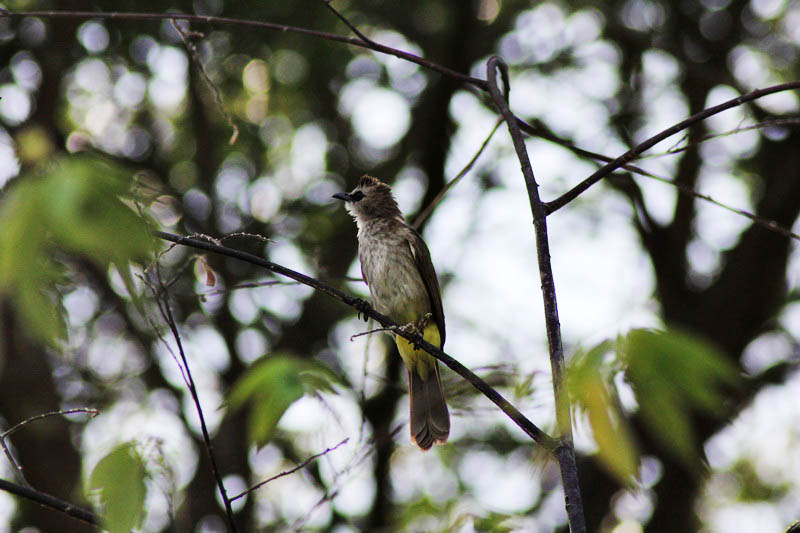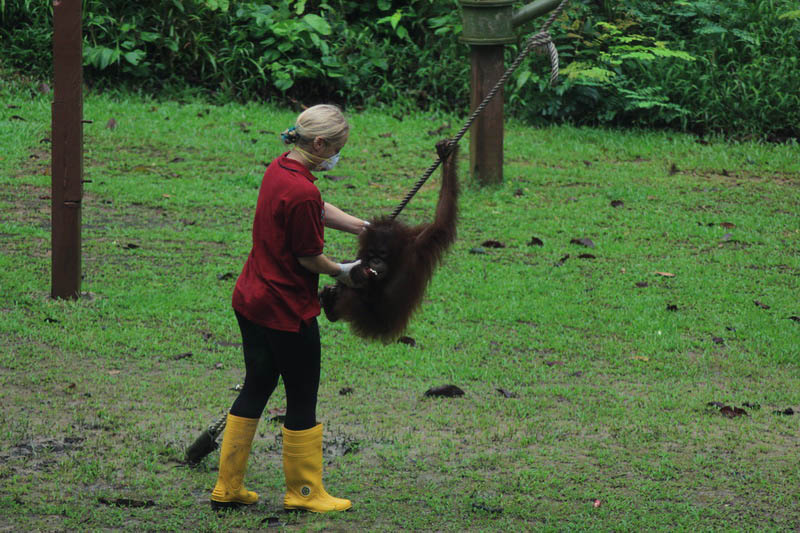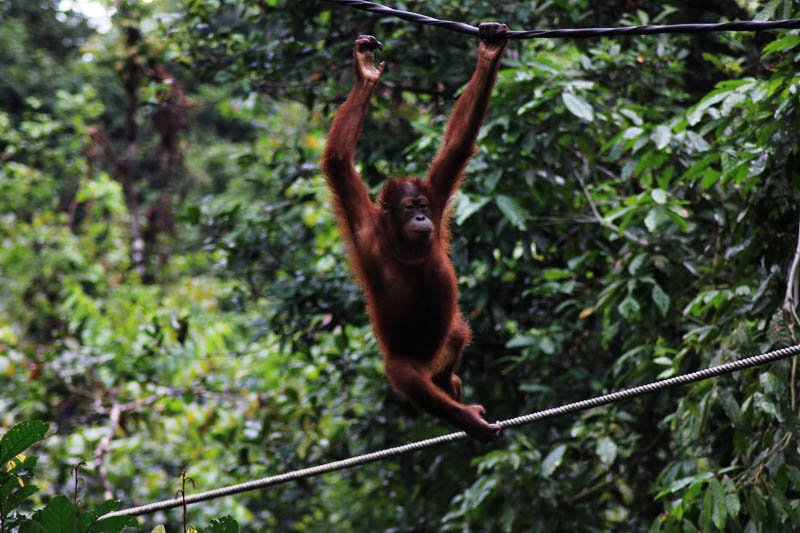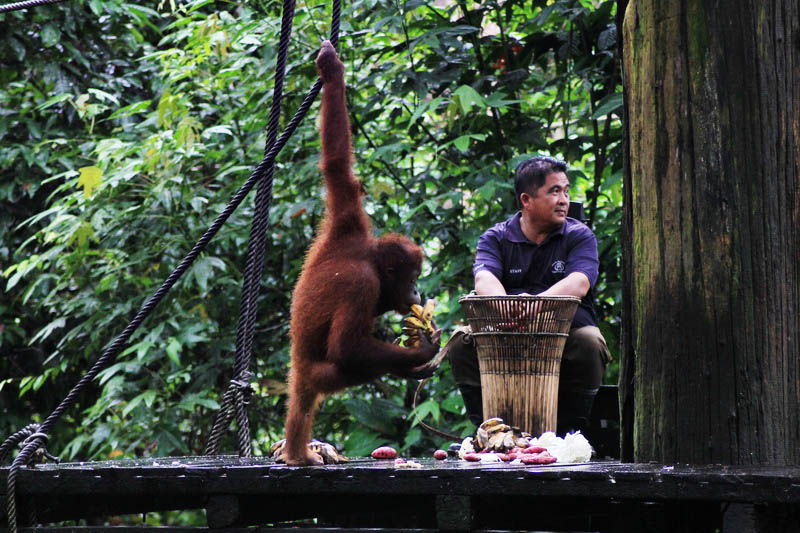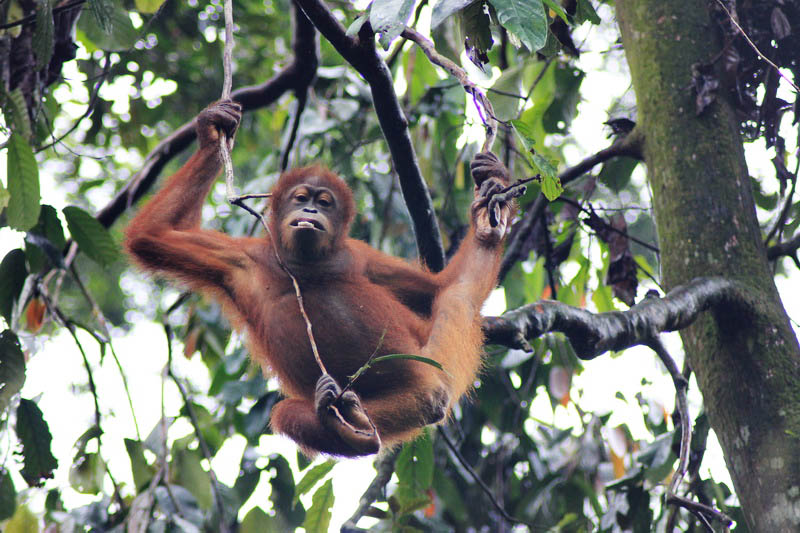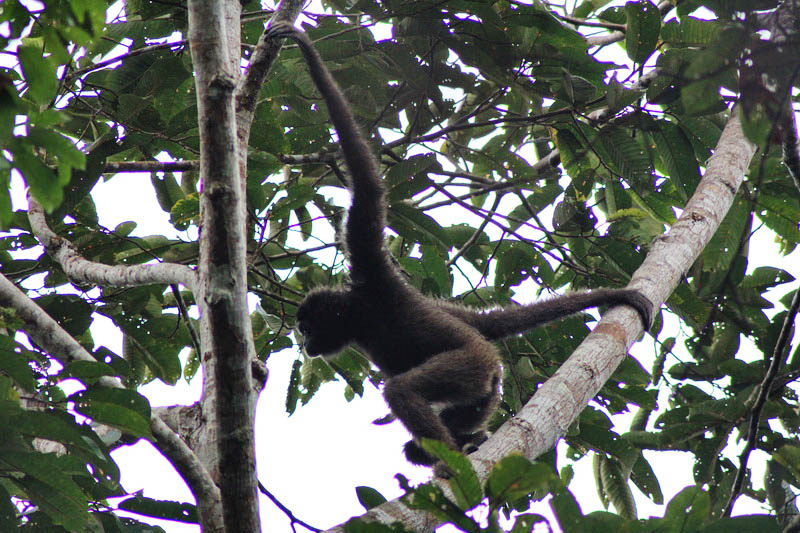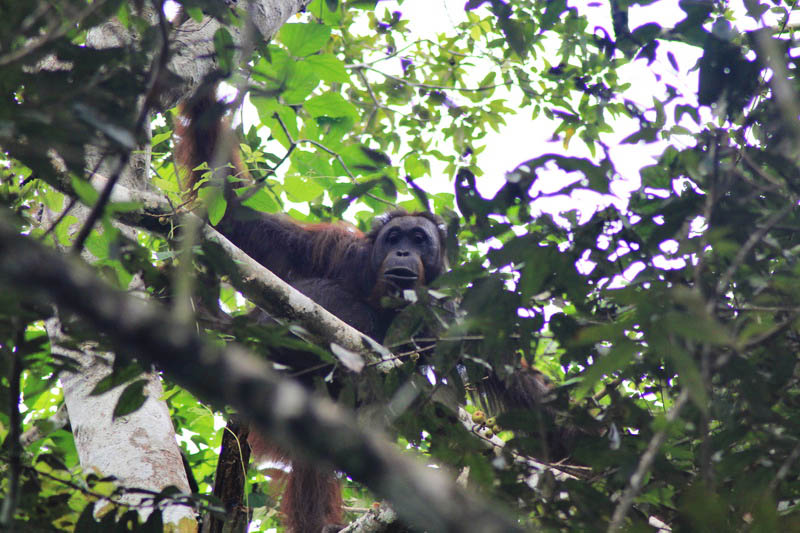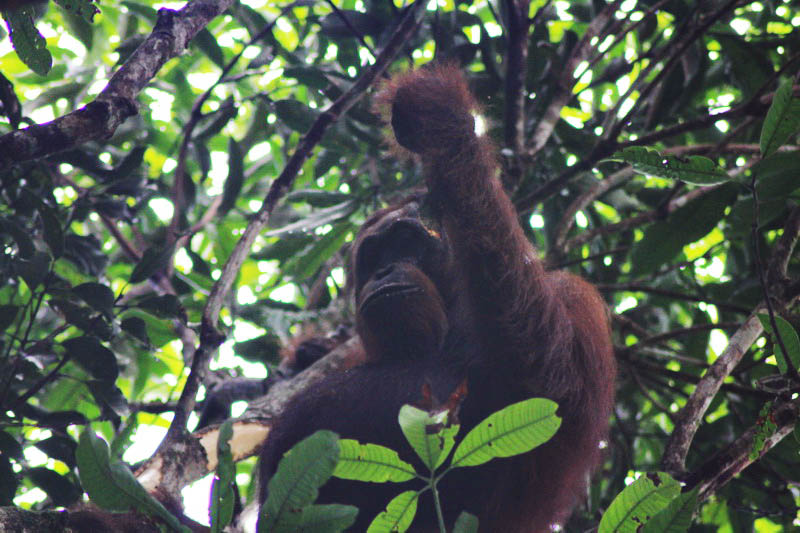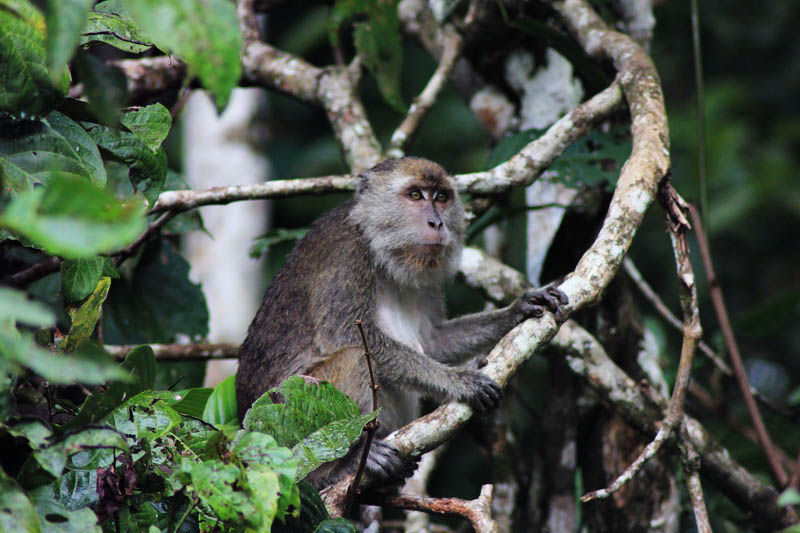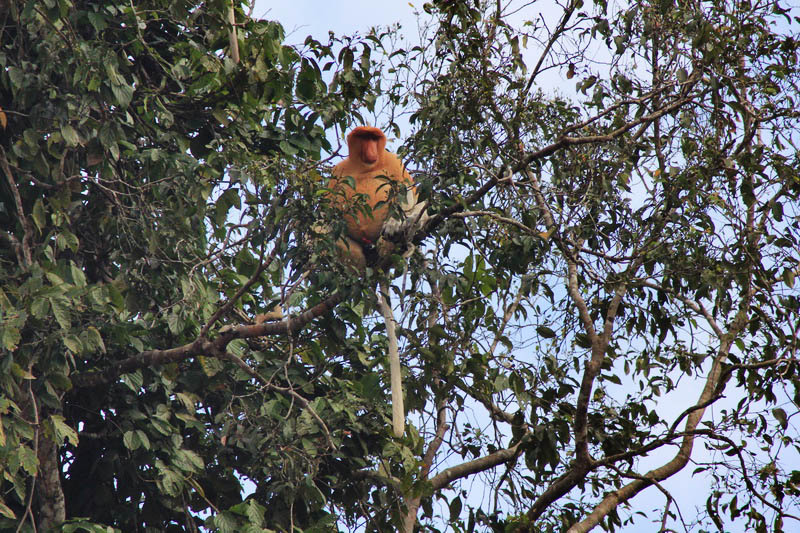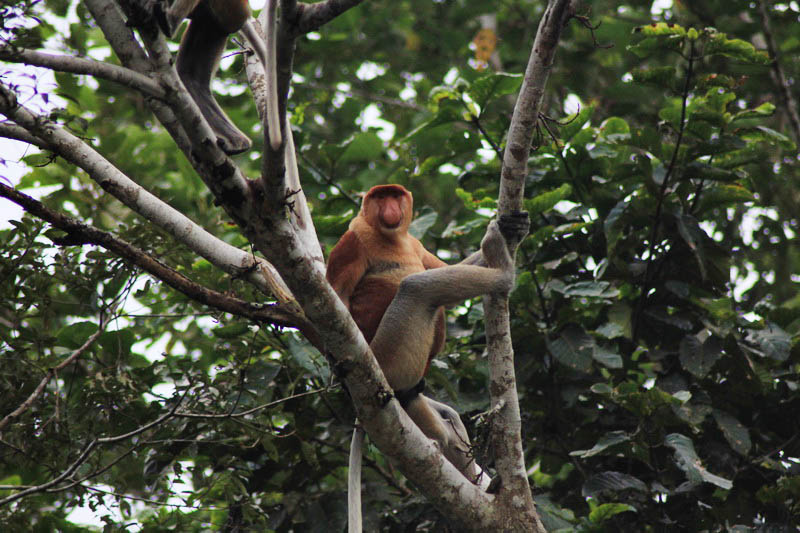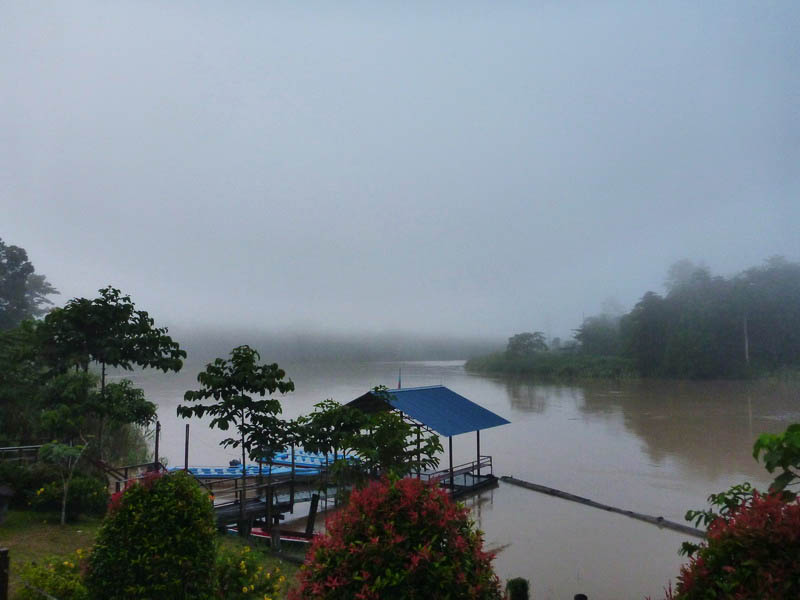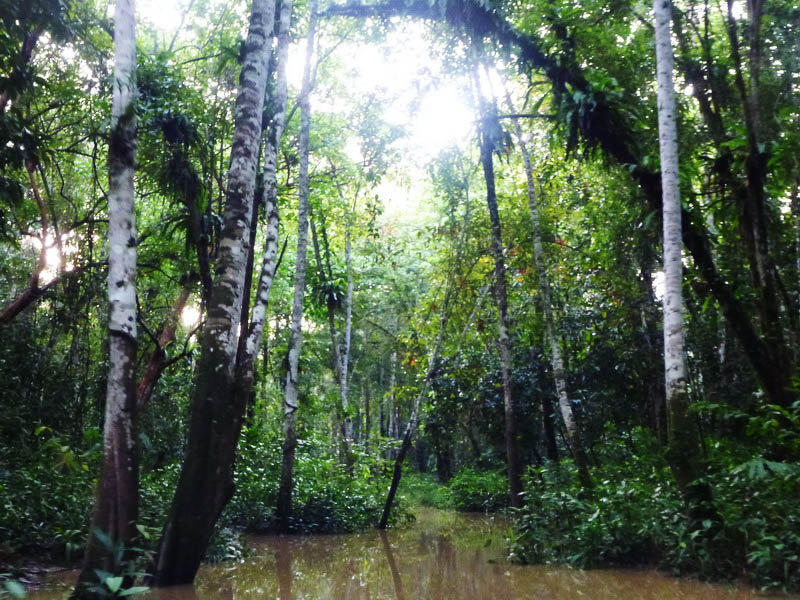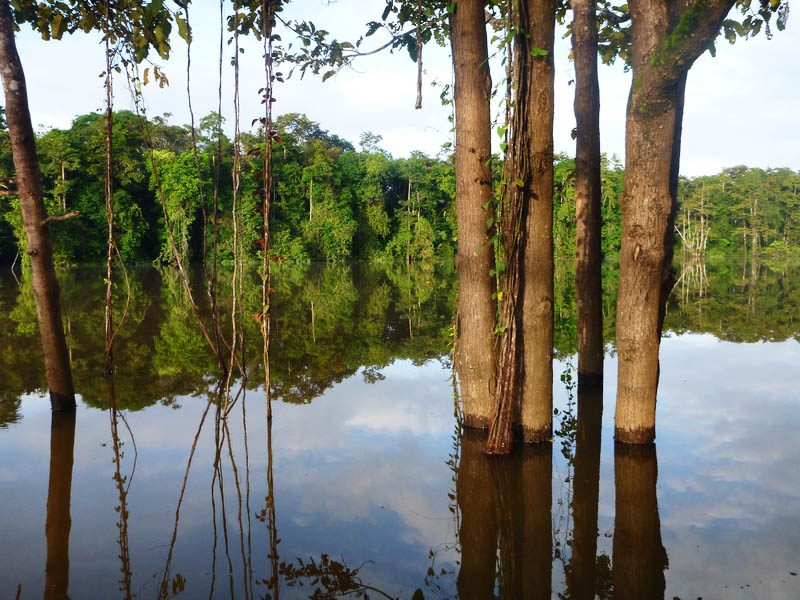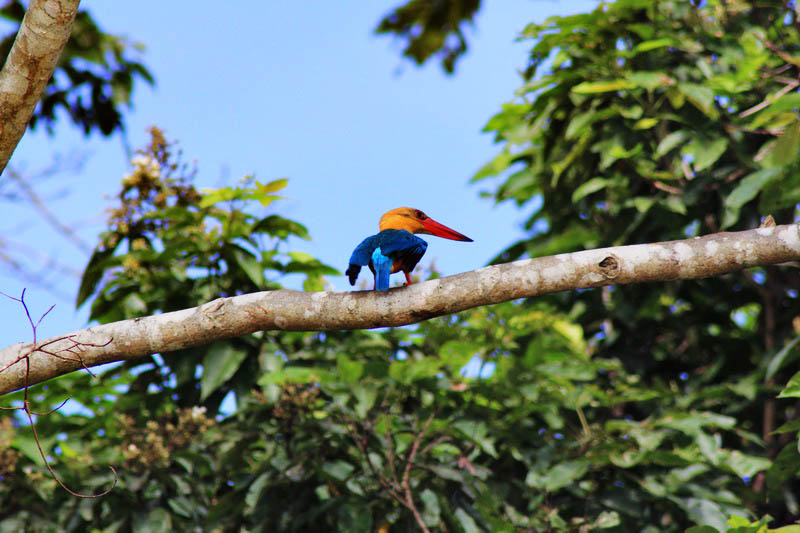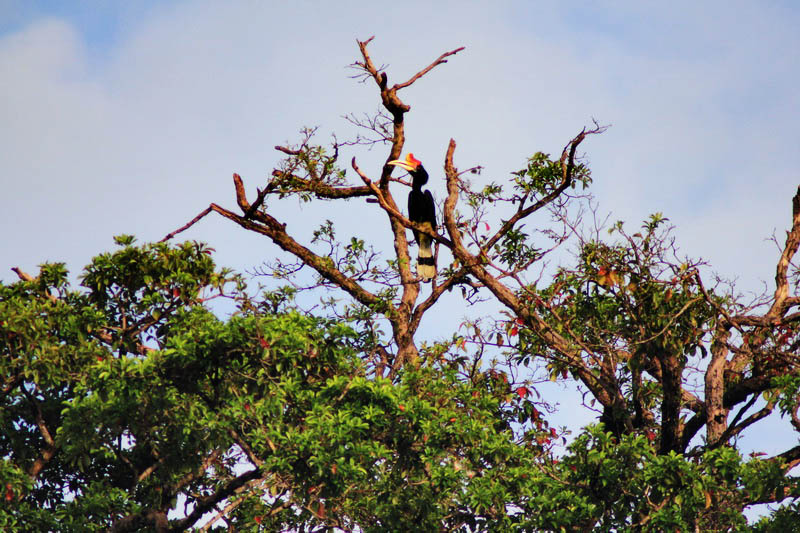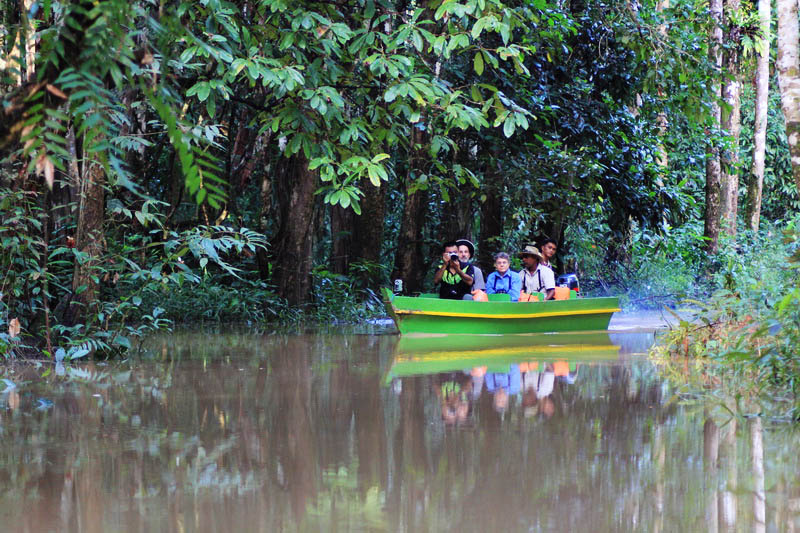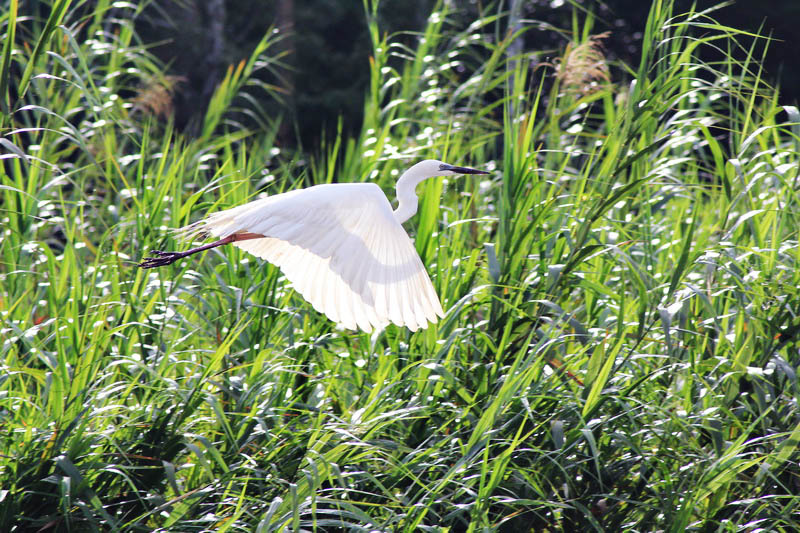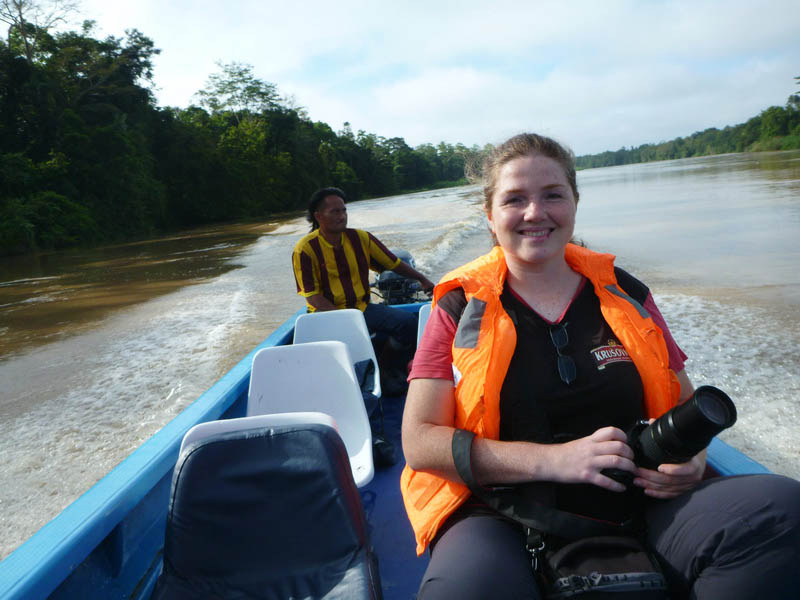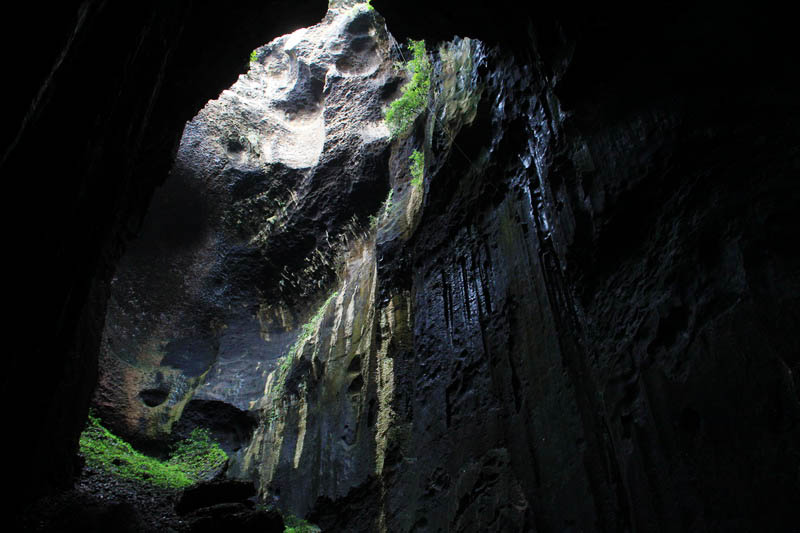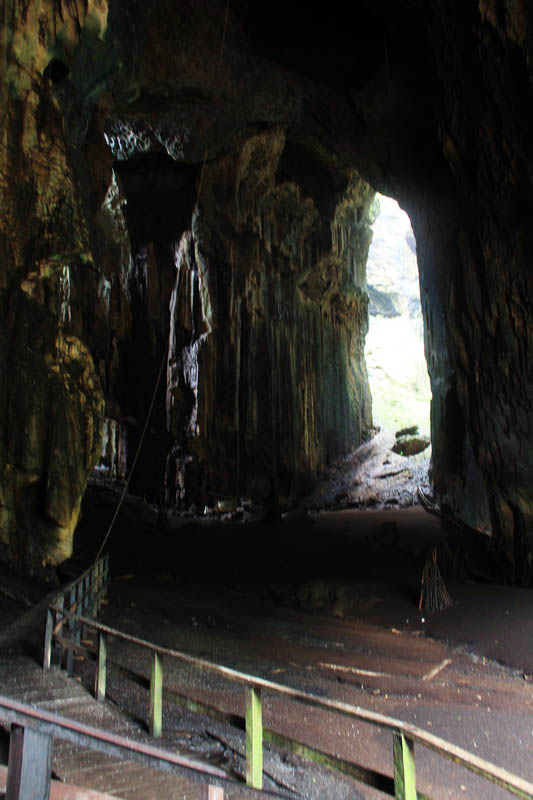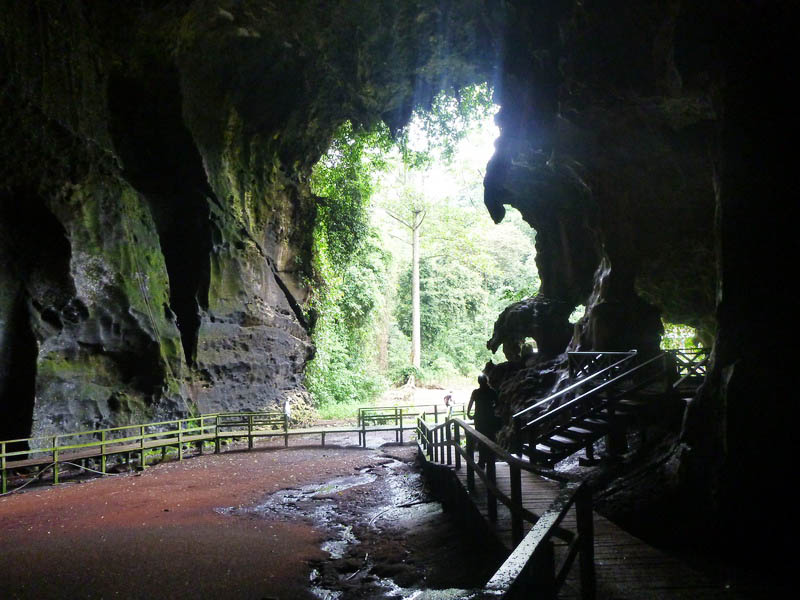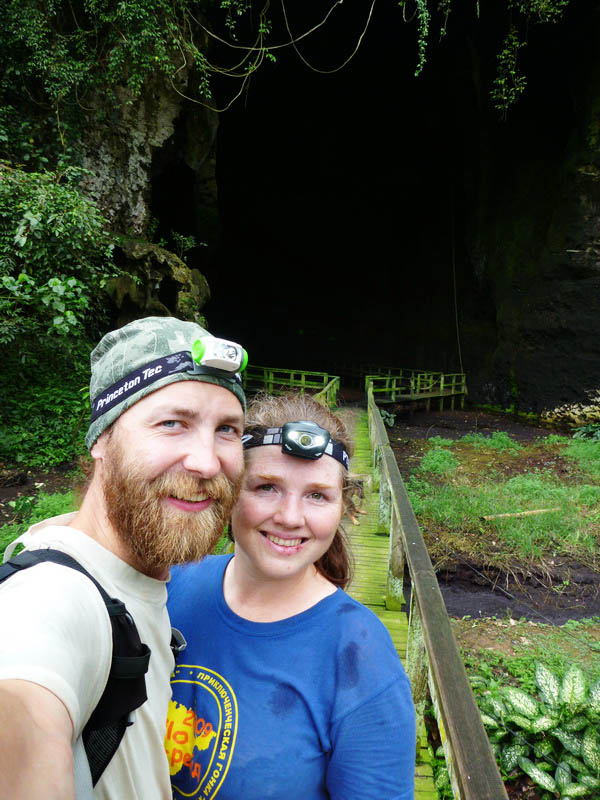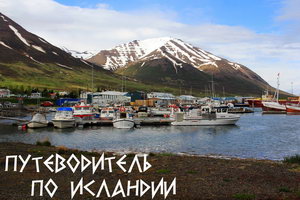Here we are in Malaysia.
From Manila, we flew to Kota Kinabalu, the capital of Sabah, which is located on the island of Borneo (Kalimantan).
Malaysia greeted us with torrential rain, but since we arrived at 2 a.m., we decided to wait at the airport in the morning. By morning, the rain had stopped, and the sun appeared in the sky.
We took a minibus to the city.
- Malaysia first impression
- Information about the cost of attractions and not only on the island of Borneo:
- Wild beach in the vicinity of Kota Kinabalu
- Lok Kavi Wildlife Park
- Moto trip to Kinabalu National Park
- Climbing Mount Kinabalu
- Information about the cost of climbing Kinabalu:
- Wetland - Mangrove Park in Kota Kinabalu
- Sepelok is an orangutan rehabilitation center
- Kinabatangan River is a wildlife sanctuary on the island of Borneo
- Gomantong Cave
Malaysia first impression
The first thing that catches your eye is a lot of women in burqas (or parades?), and mosques next door to Catholic churches. Just as I am writing these lines, the mullah is calling all the faithful to evening prayer. There are also a lot of Indians and Indian eateries, Filipino illegal immigrants who go about their usual business - selling all sorts of snacks at transport stops. There are also a huge number of Chinese tourists, Chinese shops selling dried worms and other unknown medicines. In general, an incredible mix of many cultures and nationalities.
After breakfast and settling down, we decided to relax on the beach. And since there are no beaches in the center, we decided to go to one of the islands of the Tunku Abdul Rahman National Park. Our choice fell on Mamutik Island (all the local touts assured that this is the best place for snorkeling - that is, snorkeling).
Boats to the islands depart from the embankment. Just 20 minutes and we are on the island.
As soon as we docked at Mamutik Island, we saw a lot of people and restaurants, tables that stood right on the beach. After paying for the entrance to the national park, we decided to walk further along the beach.
First of all, we check if there are corals and fish. The result is that there are few fish, corals too, and the water is cloudy. But right on the beach we met two monitor lizards who staged either a fight or mating games.
After lying on the beach, we decided to follow the path that crosses the island. And literally on the second turn we ran into a huge monitor lizard lying across the path and absolutely did not want to go anywhere. All attempts to approach the monitor lizard and get around it ended with an angry hissing and waving a meter-long tail. After getting a long branch in the nearest bushes, we were still able to move the monitor lizard a little and slip past.
The trail led us to the beach on the other side of the island, but the sea in this place could not please us with the underwater world. In general, apart from lying on the beach and visiting restaurants on Mamutik Island, there is nothing to do.
Information about the cost of attractions and not only on the island of Borneo:
- Rent a bike 45 ringgit / 1 day, if more days, then 40 ringgit
- Double room with Shared Bathroom and Toilet in Kota Kinabalu from 50 ringgit
- The entrance to the Kinabalu National Park is 15 ringgit
- Canopy Suspension Bridges 5 ringgit + 5 ringgit photography
- Boat to the islands in Kota Kinabalu 23 ringgit, port fee 7.20 ringgit
- Tunku Abdul Rahman National Park Entrance 10 ringgit
- You can get from the airport by bus for 5 ringgit or go to the highway (500 meters) and by minibus for 1.5 ringgit
- The food in the cafe is about 5-10 ringgit
- Entrance to the Lok Kawi Zoo is 20 ringgit
- Gasoline for a bike 1.9 ringgit/liter
- Durian 10-45 ringgit for a crust with peeled durian, depending on the type and quantity
Wild beach in the vicinity of Kota Kinabalu
We have been in Malaysia for the whole day, namely on the island of Borneo. The next day, we rented a bike to take a ride around the area.
We found a gorgeous sandy beach, not far from the Nexus Hotel, it's only 30 kilometers from the city of Kota Kinabalu. We got there at low tide and the beach was very wide. Perfectly smooth sand without any rocks, high waves, the absolute absence of people as far as the eye could see - perhaps this is the best beach for swimming that we have met. Along the edge of the forest, fragments of trees carried out by the sea lie in disarray, which do not interfere, but on the contrary complement the picture of solitude.
But it is worth noting that there is some kind of checkpoint on the road to the territory of these 5-star hotels. But it seems that the local guards do not even assume that the whites can violate anything and we are not from their hotels... So have more confidence and go ahead.
During their stay on the beach, they managed to understand how fast the oceanic tide is, literally in a couple of hours the water came up 6-7 meters. Of course, the gentle beach also contributed to this, but still...
We drove home in excellent sunny weather and there were only a few clouds in the sky. But these are still the tropics and thunderclouds gathered in just 15 minutes.
And on the way home, we were hit by a tropical downpour that soaked us from head to toe. We enjoyed the ride, although it was a little unusual, considering the left-hand traffic.
Lok Kavi Wildlife Park
We have already managed to ride a bike for a while and discovered a great wild beach in the vicinity of Kota Kinabalu. And so we decided to move on.
The next day, we took a bike to the Lok Kawi Wildlife Park. There we first saw orangutans, snout monkeys, gibbon, Malay bear and many others. The park is large, some of the animals are not in cages, but in pens, where they can be observed without interference.
It's worth going to Lok Kavi Park for the whole day, you will definitely have something to do.
Already at 11 a.m., demonstrations with birds begin, and at two o'clock in the afternoon, animal feeding begins.
There is a feeding schedule at the entrance to the park. They all happen at different times, but consistently, so it's enough just to come to the first feeding and continue to move after the park workers.
Sometimes the audience is also allowed to participate, of course not in feeding bears or tigers, but it's also nice for orangutans to throw a couple of bananas :)
Watching feeding animals is very interesting, you notice so many new things, and the hierarchy is immediately guessed. For example, the most important orangutan, the head of the family, threw banana skins at the zoo workers who fed him, made faces at them and tried in every possible way to show who was in charge here.
In general, Lok Kavi Park left a very pleasant impression and is definitely worth a visit.
Moto trip to Kinabalu National Park
We got up very early, we had a long-distance bike - as much as 150 km in one direction. We went to Kinabalu National Park to negotiate a one-day ascent, and at the same time stop at the Poring Hot Springs located in the same park.
The road began to climb higher into the mountains and we had a wonderful view of the valley and the clouds below. And around the next turn we saw the mountain itself, or rather the MOUNTAIN, it just struck with its greatness, and it was hard to believe that you could climb there. Kinabalu was simply amazing in its scale!
And so we drove up to the entrance to Mount Kinabalu Park. As always, the local guides began to assure us that climbing in one day is impossible, not allowed, and in general... However, after a couple of persistent questions, they sent us to the main ranger of the park. It turned out to be a normal guy who has been working in the park for more than 20 years. His name is Martin and he also tried to dissuade us from a one-day climb, but nothing worked. He asked about our climbing experience, physical training and all that. In general, we were allowed, agreed on the date and we went to the hot springs.
Judging by the map, not far from the springs, 3.5 km away, there is a large 120 m Langanan waterfall. After calculating the distance, we decided that we would definitely reach it in an hour, but... the local terrain, high humidity and debris on the trail do not allow you to move quickly, plus the climb to the waterfall is more than 300 meters.
It was going well, but then we found the first leech that had stuck. Deciding that this was a rarity, they went on. But then we realized that there were just a lot of leeches here.
Upon careful inspection, we took off a dozen leeches from our feet. Not only are they unpleasant to touch, but they are also a problem to detach from the body. It was just terrible. Then we were told that they need to be sprinkled with salt or pepper and they will fall off on their own... On the way back, I picked up a bamboo stick and stopped every couple of minutes to throw the leeches off the sneakers until they had time to get on their feet and suck. And in general, I tried to walk without touching the ground with my feet.
The waterfall turned out to be really impressive, it's a pity that all thoughts were occupied by leeches.
On the way back, we looked into the Bat Cave or simply the cave with bats, there are really a lot of them there. They woke up from our conversations and started flying, and we hurried to get out before the bats bit us too.
At the end of the walk, we walked along the Canopy suspension bridges, but a noisy group of Italians scared away all the birds. Now I understand why Italians are not liked in European resorts. Hot baths were waiting for us next.
It was getting late and we hurried home to Kota Kinabalu. But as we were in no hurry, we still got caught in the traditional evening rain. And driving along a mountain road in fog, in the rain, and even in the dark, is still a pleasure. Especially on a bike, which can hardly pull the two of us uphill, after all, it is designed for small Malaysians...
We got to the hotel in the dark, but not very late and without incident.
By the way, the other day we tried the famous Durian fruit, yes, it's the one that stinks terribly, but it's terribly delicious. Well, it doesn't stink that much, yes there is a smell, but not as disgusting as expected, but also not as tasty as hoped. In short, you can try it, but there are a lot of other fruits that are much tastier.
Climbing Mount Kinabalu
Climbing Mount Kinabalu (4095m) is one of the most popular tourist attractions in Borneo. And all because climbing a mountain with a height of more than 4000 meters here does not require any special skills, it usually takes two days with a comfortable overnight stay at the hotel, a guide leads to the top along almost a road.
To make the ascent, you need to buy a tour to Kota Kinabalu and no longer cares about anything or... decide on which side to climb to the top (the easiest way is to climb the classic route from the main gate of Kinabalu National Park), get to the entrance to the national park, agree on the date of ascent and a guide, book a place in a lodge on the mountain, find a place to spend the night next to the park on the eve of the ascent.
The two-day option allows for better acclimatization and gives people with less physical fitness the opportunity to climb. However, it is quite expensive due to an overnight stay of 3,000 at the lodge. Although there are different types of rooms, including the hostelny one.
We decided that we had enough strength to climb in one day, without spending the night on the mountain. No travel company offers this option and you have to do everything yourself.
While visiting the Poring Hot springs, we stopped by to arrange an ascent with the main ranger. We agreed on the date and time of the start. The main thing is that the ranger must allow. and you have to convince him that you have enough strength and experience.
On the eve of climbing Kinabalu, we got from Kota Kinabalu to the park and settled in the Mountain Resthouse 300 meters from the entrance to the national park. The weather on the eve of the ascent was not pleasant - it rained all day and there was a thick fog and we began to doubt whether it was worth trying at all.
The morning saddened us with an even thicker fog, but while we ate and reached the entrance to the national park, the blue sky began to show in some places. Doubts still remained, because even for a one-day ascent you have to pay a lot of money.
As a result, it was decided that only Pasha would go on the ascent, his pace is higher and he has a better chance of seeing something, because even with good weather in the morning after lunch, clouds cover the top.
Having paid all the fees and received a guide, Pasha went to the top.
The trail starts from the Timons Gate, where you can get a ride on beads. At Timons Gate, we saw that all the clouds remained below, with a cloudless sky and an open mountain top above us.
We started at 7:30 a.m. It is only 8.5km from the gate to the top, but the climb is about 2300m. A wide path leads through the jungle to the top. Part of the trail consists of wooden and stone steps, or a scattering of stones. Going up the trail is easy and my guide and I were ahead of schedule.
To be allowed to the top, it is necessary to climb to the lodges at 3000m before 12, we were there at 10 am. After drinking a cup of tea in the local canteen and taking more with us, we continued our way to the top.
From the lodges, the trail becomes steeper and soon comes out onto bare rocks. A rope is hung along the path along the stones. By 12 o'clock we reached the top.
Since no one else did the ascent in 1 day today, the peak was completely deserted. All the ascenders have already gone lower in 2 days.
Gradually the clouds were rising from below, but the top was still open. After taking a few photos, admiring the beautiful scenery and having a snack, the guide and I began the descent.
Going down the stairs is more tedious than going up. On the way, we passed a lot of people descending, all of them descending after a 2-day ascent. Many were limping and walking very slowly, apparently the steps are making themselves felt.
At 15:40 we went to Timons Gate, and at 16:00 we were downstairs at the entrance to the national park. So if you are confident in your physical fitness and you are lucky with the weather, then climbing in 1 day is quite realistic.
Information about the cost of climbing Kinabalu:
Climbing in two days in travel agencies from 800 ringgit
The climbing permit is 100 ringgit ordinary and 200 ringgit expeditionary, 200 are charged for a 1-day ascent.
Guide services 150 ringgit group of 1-3 people, if more people, then a little more expensive
Compulsory insurance of 7 ringgit
Travel to Timons Gate one way from the entrance to the park 17 ringgit
Passage Kota Kinabalu - National Park 20 ringgit
Accommodation in Mountain Resthouse double room with amenities of 60 ringgit, with shared shower and toilet of 50 ringgit.
Entrance to the national park for a walk 15 ringgit
Walk from Timons Gate to Mesilau Gate 10 ringgit (without climbing to the lodges)
If you are tired of carrying your backpack, the guide can carry it for only 5 ringgit/kilogram
Wetland - Mangrove Park in Kota Kinabalu
Wetlands park is located right in the city of Kota Kinabalu, if you look from the sea, then right behind the signal hill and on the google map it is marked as a golf course.
You can walk from the city center to Wetlands in 15-20 minutes on foot, visiting the observation deck on signal hill on the way.
This is something like a small park showing the life of mangrove forests.
You can move around the park on wooden bridges, because otherwise you would have to walk knee-deep, or even waist-deep in water and mud.
There are few people in the park, so there is every chance to observe wild life.
The first ones that catch your eye are herons - there are many of them and they are different.
Then you start looking at the ground, and there is another life in full swing - different crabs, mud lobsters, mud jumpers and other animals.
After walking along the catwalks, we managed to see several species of crabs, two species of mud jumpers, mud lobster, 4-5 species of herons, some bird unknown to us, and a fleeting flight of fishing birds.
And there is also a telapia fish on the beak of a heron.
We were in the afternoon, but still the best time to visit is morning or evening, but we must take into account that the center is open from 8 to 18.
The entrance fee is 15 ringgit, the time spent inside is unlimited.
Sepelok is an orangutan rehabilitation center
After climbing Mount Kinabalu, we arrived in the city of Sandakan, the southernmost point of our journey.
One of the main attractions of Sandakan is the Sepelok Orangutan Rehabilitation Center located nearby. The Sepelok Center is engaged in the rehabilitation of orphaned orangutan cubs and their return to the wild.
There are several trails for observing orangutans across the vast territory of the center.
But to be honest, you have quite a few chances to meet orangutans just walking along the trail. After all, it is almost impossible to notice an orangutan sitting motionless, and even among the dense foliage. But there is a real chance to see macaques.
But there are still a couple of places in Sepelok Park where it is almost guaranteed that you can see orangutang. The first is a feeding place - orangutang are fed twice a day at 10 and 15 o'clock. Orangutang may or may not come to feed. The chances of seeing orangutang here decrease during the fruit ripening period.
The second place is the kid's learning center, but there you will have to watch the animals through the glass. We were lucky, an adult male came to the training center, sat, watched and left. Only two young orangutang came to feed... And a flock of macaques.
In general, the center of Sepelok is a good place, but it doesn't make sense to go to Sandakan just for it. And if you really want to see orangutang and you are in Kota Kinabalu, then it is easier and better to go to the Lok Kawi Zoo and look at them without bars and nets through a narrow water barrier.
The entrance fee is 30 ringgit. Taking photos on a phone, tablet for free, and on a camera 10 ringgit.
Kinabatangan River is a wildlife sanctuary on the island of Borneo
Perhaps the most popular tourist destination, which is transported from Sandakan, is the Kinabatangan River.
Having not heard anything about her before, but after reading the brochures, we decided to go on tour for two days and one night. They promised a lot of animals and birds, excellent living conditions, but also wanted from 300 to 1500 ringgit for this pleasure, depending on the resort.
In some travel agencies, for an additional fee, other attractions are brought along the way: the Sepelok center, Gomantong caves, the rain forest center, etc. We took advantage of this service and added the Sepilok Rehabilitation Center and Gomantong Caves to our tour.
To be honest, going to Kinabatangan, we did not expect to see many animals and birds, well, maybe at least a macaque or a couple of birds... and that's all, and gorgeous photos in agencies were considered fake. But fortunately we were wrong... And so 2.5 hours away we arrived at the Myne resort. We were greeted with glasses of cold mango juice, and while we were cooling off, local workers had already taken our things to the room. We were immediately seated for lunch after a long journey.
After lunch, we were given half an hour to get comfortable in the room, then a walking tour through the jungle was planned. The room was amazing in its scale. It is designed for 4 people, and there were only two of us. Mineral water, tea, coffee, washing facilities and even toothbrushes with small tubes of paste are in the room.
And so we go into the jungle. There is a guide ahead who does not understand English at all, but knows the names of pets and animals in English. Sometimes he goes on a prowling pike and looks out for something carefully.
As soon as we entered the forest, we startled a flock of rhinoceros birds. After another few minutes, gibbons were spotted. But they also escaped pretty quickly. It looks like there really is something in the local forests.
The trail passed next to another local landmark, the iron tree. Its trunk is hollow, and you can climb into it, and bats live inside.
We have almost returned to the hotel along the trail, having not met any other animals. But accidentally turning around, they noticed something big and dark on a huge tree. Looking closely through the camera lens, we realised that it was an orangutan. Our guide, apparently, was also surprised and delighted. Then our guide quickly broke through the bushes to the tree, while not forgetting to look at us and move branches out of the way for us.
Through the mud, reeds and bushes, we came close to the tree on which the orangutan was sitting. Unlike gibbons, he was in no hurry, but was passionate about eating some fruits and did not pay any attention to us.
In search of a suitable angle, we cracked bushes and laid new trails. Ignoring us, the orangutan only lazily moved from branch to branch, sometimes dropping fruits and pieces of bark, from which he stripped the inside for food. After watching him for 40 minutes, we decided to leave him alone and went to the hotel.
A light snack and a boat is waiting for us for an evening cruise on the Kinabatangan River.
Five minutes after departure, we saw a flock of macaques sitting in a tree right above the water.
Five minutes later, we saw another flock of monkeys, this time they were proboscis or, in our opinion, nosy monkeys.
As it turned out, life is just boiling on the coastal trees. As we learned later, the monkeys converge to the river to spend the night. Boats with tourists were scurrying back and forth along the river. Any animal other than macaques and proboscis attracted close attention.
That evening, we met more than once nosy monkeys, macaques and other animals, the names of which we did not remember.
The next day, early in the morning, we set off on another cruise on the Kinabatangan River.
We turned off the river into an inconspicuous channel that led through the jungle. The width of the channel was slightly larger than a boat and huge trees closed their crowns above the water.
It wasn't long before we saw some kind of opening. The channel led us to the lake Ox-Bow. It looks like we were the first people on the lake that day. The surface of the lake was absolutely smooth, and the coastal trees were occupied by rhinoceros birds, which spread their wings to meet the morning sun. Herons of several species strutted majestically along the water's edge.
After scaring the animals away a little with the sound of the camera shutter, we returned to the Kinabatangan River. There were almost no monkeys that day, but there were a lot of birds.
Several times we managed to swim almost close to Kingfisher.
Unfortunately, our stay in this wonderful place has come to an end. In one and a half days we saw more wild animals and birds than in the rest of the time in Malaysia. Despite the high price, such a tour can be recommended to all lovers of wildlife. And as the Internet suggested, you can find much more budget accommodation options on the river. The main cost is a transfer, so if you stop by for a week...
Unfortunately, the reason for such a large number of animals and birds along the banks of the Kinabatangan River is very banal - almost all the forests in this region have been cut down and now there are plantations of oil palm trees in their place. Animals and birds were left with only a narrow strip of forest along the river.
Cost Information:
- Kota Kinabalu - Sandakan 43 ringit Bus
- The bus from the bus station to the city center of Sandakan is 10 ringgit (or at least they ripped us off like that)
- Accommodation from 60 ringgit per double room
- Entrance to the Septic tank is 30 ringgit, photography is 10 ringgit
- The entrance to the Gomantong caves is 30 ringgit, photography is 30 ringgit, but no one was watching
- Excursion 2 days 1 night to the Kinabatangan river with accommodation in a double room from 300 ringgit, with accommodation in a dorm from 270 ringgit
- An additional option for the tour is 50 ringgit (entrance fees are included)
Gomantong Cave
Gomantong cave is a huge cave in Malaysia, on the island of Borneo, a 2-hour drive from the town of Sandakan. It is famous for collecting the nests of swallows nesting here. These nests are exported to China, where they are considered a delicacy.
Ropes and ladders have to be used to collect them, because the nests are located under the roof of the cave, at a height of up to 90 meters.
In fact, there are several caves in this mountain, which is also called Gomantong. But the most popular among tourists is this one - the black cave. The "floor" in the cave is covered with a thick layer of bird and bat excrement, and giant cockroaches are swarming all over it
At the entrance to the cave there is a village, the inhabitants of which take down the nests of swifts several times a year. This event has already become a kind of ritual, which attracts a lot of people.
The entrance fee is 30 ringgit
Permission to take photos is 30 ringgit (but we did not take it and no one was watching)
